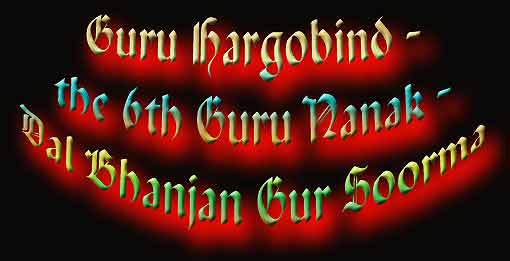| | | | | | | | | | | | | | | | | | | | | | | | | | | | | | | | | | | | | | | | | |
| Menu | | | | | | | | | | | | | | | | | | | | | | | | | | | | | | | |
| | |
| | | 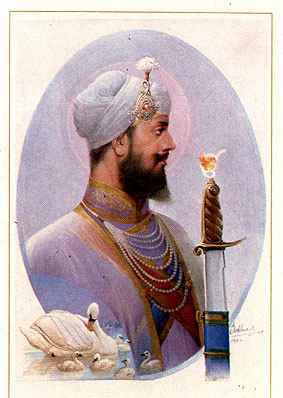 | | | | | | | | | | | | | | | | | | | | | | | |
| | | | | | Guru
Hargobind was the only son of Guru Arjan and Mata Ganga. He was born at village
Wadali near Amritsar in June 1595 AD. He received his early education and training
at the hands of the revered Sikhs of the time Baba Buddha and Bhai Gurdas. He
was barely eleven years of age when his father Guru Arjan was martyred in May
1606 AD and the responsibility of leading the nascent community fell on him. He
responded to the situation by adding a new dimension to Sikhism. Right from the
day of his installation, he started wearing two swords-one for meeri and the other
for peeri to emphasize the complementary nature of the spiritual and the temporal.
As a further step, he laid the foundation stone of the Akal Takht as the highest
seat of temporal authority of the Sikh community opposite the Golden Temple, which
is the highest spiritual centre. Guru Hargobind started dispensing justice from
the Akal Takht, a practice that has continued up to the present times. | |
| Threatened
by the increasing and improved organisation of the Sikhs, Emperor Jahangir had
him detained in the Gwalior Fort for 12 years. But this only enhanced his reputation.
During this period Baba Buddha and Bhai Gurdas looked after the affairs of the
community. When Shah Jahan became the emperor in 1628 AD, he intensified the oppression
of the Sikhs. As a result, the Guru had to fight four battles against the imperial
forcesThis represents a break from the sant traditions of the earlier Gurus. Guru
Hargobind did not compose any hyrnns either. The Guru founded Kiratpur in the
Himalayan foothills and spent the last few years of his life there He passed away
in March 1644 AD at Kiratpur. Guru Hargobind, like his predecessors, lived a married
life. He had six children-five sons and a daughter. Gurditta, Ani Rai and Bibi
Viro were born to Mata Damodari, Suraj Mal and Atal Rai to Mata Mahadevi and Tegh
Bahadur to Mata Nanaki. Two of his sons, Baba Gurditta and Atal Rai died in his
life-time. The Guruship was passed on to Guru Har Rai, grandson of Guru Hargobind
(son of Baba Gurditta) after the latter's death.. | | | |
| | | | | | | | | | | | | | | | | | | | 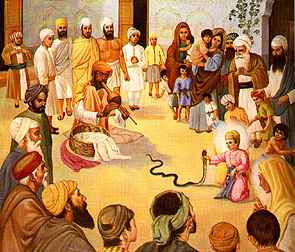 | | |
| | | The
Invincible Guru Several fruitless
efforts were made on the life of Guru Hargobind right from his infancy. A snake-charmer
was bribed who let loose a poisonous snake. But the Great Guru overpowered the
snake. | | | | |
| | | | | | An
orphan Pathan lad Paindey Khan (d.1634 AD) was brought up and trained in the art
of warfare by Guru Hargobind Sahib. Paindey Khan led Mughal forces against Guru
Ji and died at the hands of the Guru at the battle of Kartarpur. Before the Pathan
breathed his last, Guru Ji asked him his last wish. He begged to be pardoned.
Guru Ji forgave him and covered his face from the burning sun with his shield. | | | | | | | | | | | | | | | | | | | | | | | | | |
| | | | | | | 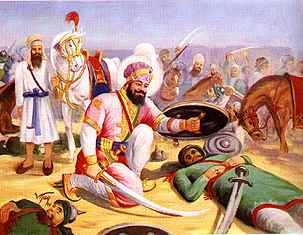 | | |
| 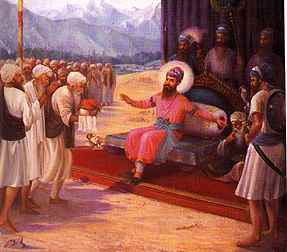 | | | | | | | | | | | | | | | | | | | |
| | | | The
Sikhs in order to have 'darshan' and blessings used to visit Guru Hargobind Sahib.
And, also desired to offer some gift to the Guru. Once, the leader of Sangat offered
honey as a gift, which the Guru Sahib declined to accept, saying, "I have
asked for the same on the way and you refused." This shocked the Sikh and
soon after the honey had become unfit for human consumption. | | | | | | |
| | | | | The
Sikh begged for enlightenment. Guru Ji told him by pointing towards Bhai Kattu,
the poor Sikh, who was hungry and was refused when requested for the honey while
accompanying the Sangat. Guru sahib further enlightened him, saying, "Gharib
Da Muh - Guru Ki Golak." (Feeding the poor is actual feeding the Guru) | | | | |
| | | | | | | | | | | | | | | | | | | | | | | | | | | Mata
Sulakhni is remembered in history as a woman of deep faith and piety. Here she
is seen seeking the blessings of Guru Hargobind. She was childless. She implored
Guru Sahib saying, "you decided my fate before I was born; you alone can
re-write it." She received the blessings of Guru Hargobind and had seven
children who sacrificed their lives for the cause of the Guru, which she accepted
with faith and resignation. | | | | |
| | 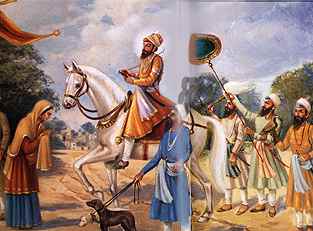 | | | | | | |
| | | | | | | | | | | | | | | 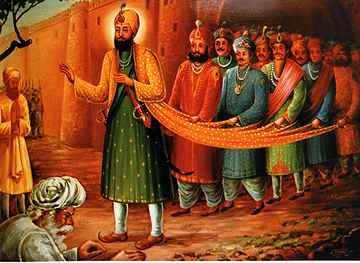 | | | | | | | | | | |
| | | Bandi
Chhod Satguru Guru
Hargobind ordained Sikhs to arm themselves to resist injustice and tyranny. This
annoyed Emperor Jehangir who ordered incarceration of the Guru in the Gwalior
Fort. Soon realising his mistake, the Emperor ordered his release but the Guru
refused to accept the offer till 52 innocent 'Rajas' were also freed. Instructions
were issued that whosoever holds the Guru's dress will be freed. Guru Ji wore
a special apron with 52 strings attached to it. Each Raja held one string and
walked into freedom. 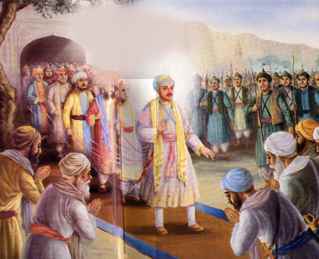
The
Guru when reached Amritsar, co-incidently it was a Diwali day - hence it added
another happy moment to the previous celebrations enjoyed by the Sikhs and Hindus
alike. | | | | |
| | | | | | | | | | | | | | | | 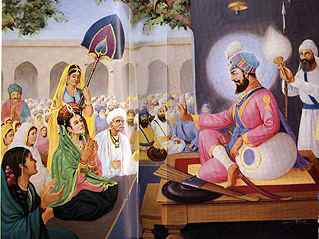 | | | | | | | | | | | |
| | | | | | | Queen
NOOR JEHAN (1591-1645 AD), who was an ardent disciple of Mian Mir, once went to
Lahore to seek the blessings of Guru Harghobind. Answering one of her queries,
Guru Ji enlightened her by saying that he never forgets death and always remembers
God. Guru Ji counselled her not to engage herself in the persuit of wordly things
but instead she should try to comprehend truth and discharge the duties of a true
wife. | | | | | | | |
| | | | | | | | 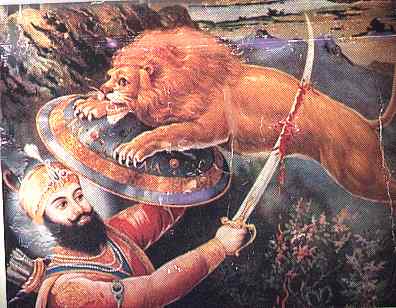
To
infuse Martial Spirit in the Sikhs, Guru Hargobind taught the warriors to hunt
ferocious animals such as lions 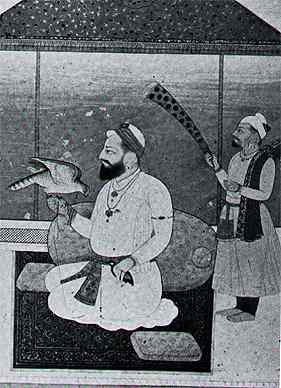
Guru
Hargobind - a painting from the Lahore Museum (courtsey F.Aijazzudin) Guru
hargobind is shown seated on a patterned carpet. He holds a falcon on one hand
and a black partridge in his left fist. He is dressed plainly in a white'jama'.
A servant stands behind waving a peacock-feather 'chauri'. | | | | |
| | | | 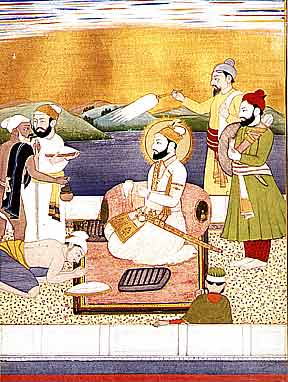 | | | | | | | | | | | | | | | | | | |
| | | | | | | | 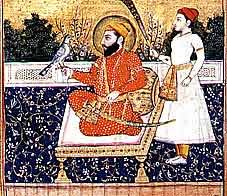 | | | | | | |
| | | | | | | | | Both
these painting of Guru Hargobind Sahib by Muslim artists. (Courtesy Randhawa,
"The Sikhs, Images of a Heritage." | | | | | | | | | |
| | | | | | | | | | | | | | | | | | | | | 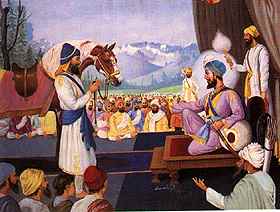 | | | | | |
| | | | | | | | | | Guru
Hargobind had asked his Sikhs to bring weapons and horses to him so as to strengthen
his army. Here a Sikh brings a horse in His darbar. | | | | | | | | |
| | | | | | | | | | | | | | 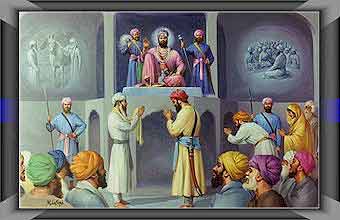 | | | | | | | | | | | | |
| | | | | | | | | Guru
Hargobind holding his Darbar atop the Akaal Takht, Amritsar | | | | | | | | |
| | | | | | | | | | | | | 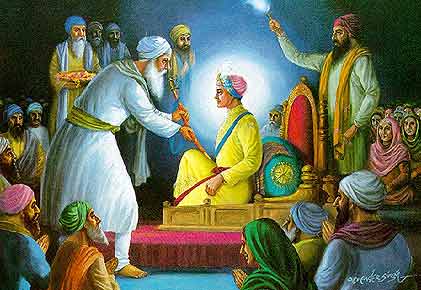 | | | | | | | | | |
| | | | Baba
Budha Ji handing over the Gurgaddi to the young Hargobind. Here he also adorned
him with two sword - one of Miri and the other of Piri. 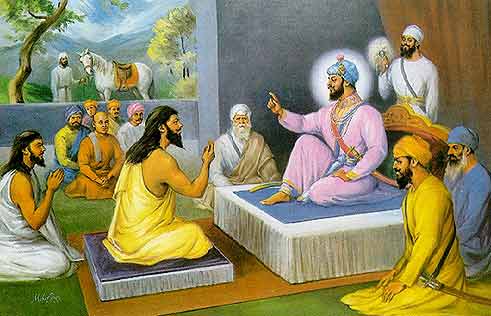
At
Sri Nagar (Garhwal) Sant Ramdas Samrath, the spiritual guide to Shivaji Marhatta
met Guru Hargobind. The Sant seeing the Guru's regal splendour and ornaments,
expressed doubts that 'an heir to the throne of Guru Nanak, the ascetic - and
in this attire?'. The Guru convinced him by saying that words do not make an ascetic
or disguise can make one rich. Weapons are for the protection of the poor and
a mark of the valiant. 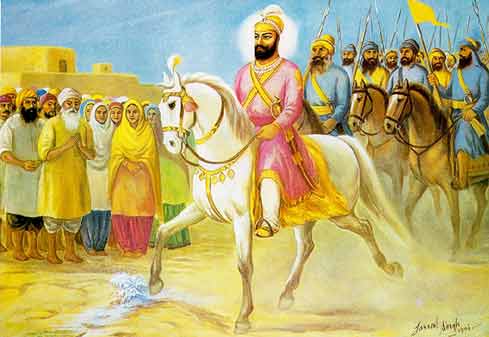
During
on on his travels Guru Hargobind once was in a village Addi in the Ludhiana district,
when the people begged Guru Ji to provide water for them as there was no water
in their area. Guru Ji obliged the people and his horse dug in the earth and water
gushed out of it. 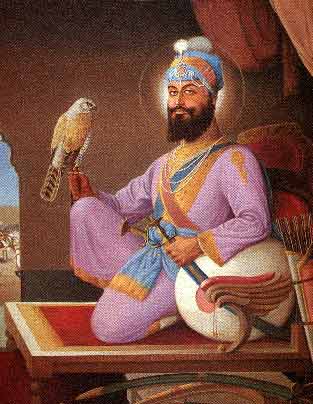
Guru
Hargobind, wielder of the Miri & Piri swords. 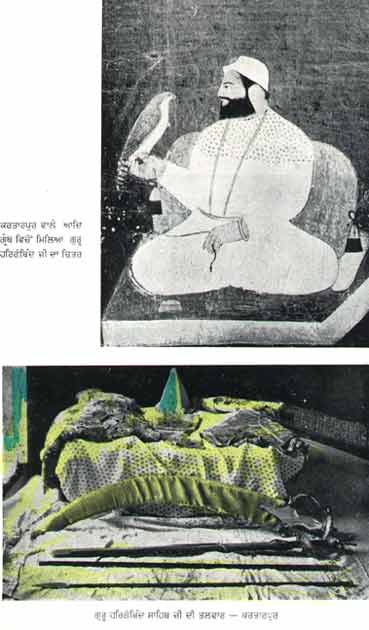
A
very rare portrait of Guru Hargobind found in an Adi Granth at Kartarpur &
The sword and seli topi of Guru Hargobind at Kartarpur. 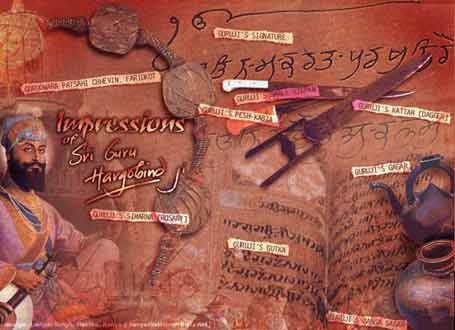
Some
relics of Guru Hargobind. 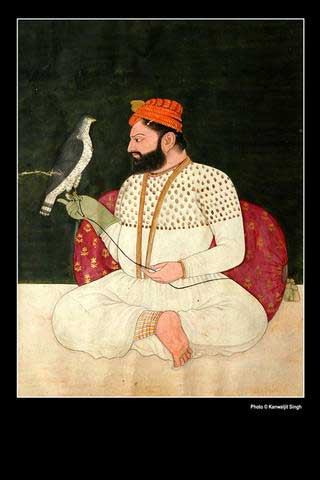
Guru
Hargobind (courtesy Prof. Balwinder Singh) 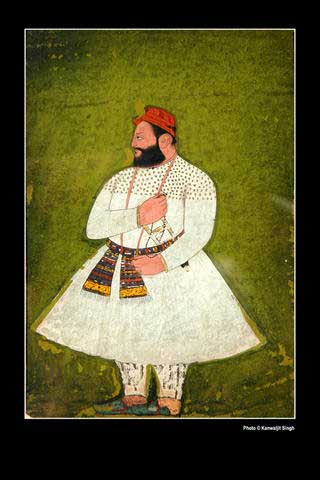
Guru
Hargobind Sahib(courtesy Prof. Balwinder Singh)

The hand script of Guru Hargobind in a pothi kept at the Amritsar Museum
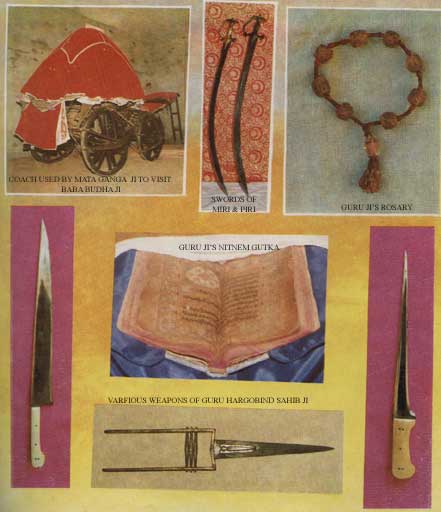
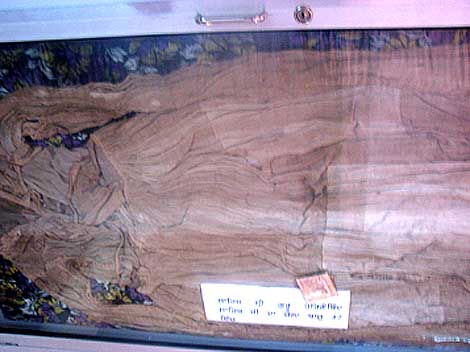
Chola of Guru Hargobind Sahib ji at Daroli Bhai, house of Bhai sain das ji where Guru ji lived for 3 years along with mata Damodri ji. (photo courtesy Prof. Balwinder Singh)
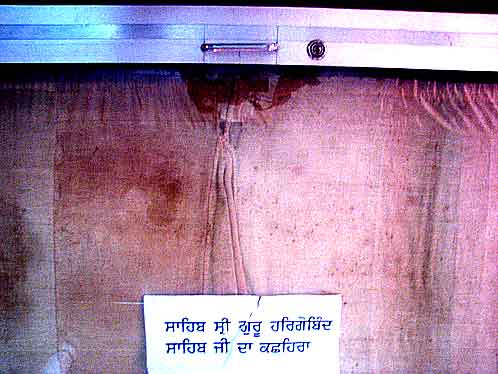
Kachera (under pants) of 6th Guru sahib at Daroli Bhai.(photo courtesy Prof. Ballwinder Singh)
MENU | | | | |
 |  |  |  |  |  |  |  |  |  |  |  |  |  |  |  |  |  |  |  |  |  |  |  |  |  |  |  |  |  |  |  |  |  |  |  |  |  |  |  |  |  |
